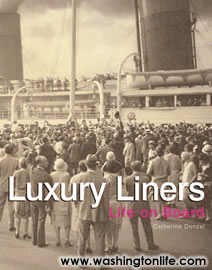|
Artfully Noted Washington Times' Society Editor Kevin Chaffee pours through two new coffee table books
DISCO YEARS They are all here. The first-name-only set who populated the New York club scene in the '70s and '80s: Andy, Liz, Liza, Mick, Bianca, Madonna, Cher, Rudi, Halston, Raquel, Arnold, Truman, Rod. Disco Years is a marvelous flashback to the days of Studio 54, Xenon and the Area Club. Ron Gallela, dubbed by Time magazine as "the godfather of American paparazzi culture," was there to record it all - whether his subjects liked it or not. All the shots are candid, of course, the hallmark of any respectable paparazzo. There's a totally blotto Truman Capote, who may or may not be wearing anything under his coat, gradually sliding off his banquette; an amazingly obese Elizabeth Taylor caught in what would later become the cover photo of "Hollywood Babylon II"; impossibly young and handsome John F. Kennedy Jr. making the scene with his girlfriend du soir; plus the usual complement of freaks, drag queens, nearly naked busboys and topless starlets cavorting on the dance floor in gold glitter or in Studio 54's damp, dark and druggy basement "VIP Room" (the only place to be for la creme de la dregs). As Anthony Haden-Guest notes in his introduction, "Things are rough for paparazzi these days." There's legislation which drastically restricts their activities and hired goons to beat them up, to say nothing of "picture-eating" cellphones. Anybody can be a paparazzo now, he points out. And it's true. But it's not nearly as much fun when everyone's 15 minutes are already up.
LUXURY LINERS: LIFE ON BOARD Veteran passengers and landlubbing ocean liner buffs alike will find much to admire in a superb book that lovingly recreates life aboard the Normandie, Queen Mary, Ile de France Rex, United States and many of the other great leviathans during the heyday of travel on the high seas. Those familiar with the wet T-shirt contests, mall-like atmosphere and indifferent service that are the norm on many of today's cruise ships will marvel at the luxury and style of their famous early and mid-20th century predecessors. The transatlantic "crossing" (please don't call it a "cruise") began with an exciting departure featuring bon voyage parties, popping champagne corks and bellboys delivering telegrams, flowers and baskets of fruit. After embarking (streamers! blasting horns! waving crowds!), there was the all-important examination of the passenger list to see who else might be sailing, and the unpacking of steamer trunks. Then one settled in for the next four to six days (depending on the speed of the ship). Routine onboard was deliciously languid: breakfast in bed, then perhaps a stroll on the promenade deck followed by bouillion (or "elevenses") whilst snuggling under a steamer rug at one's deck chair with a good book. Next came a four-course lunch, with late afternoons devoted to a swim in the pool or a turn at shuffleboard, quoits or skittles on deck. Afternoon tea (always best on British ships) was at four. After a short nap, one dressed for dinner and emerged around seven for cocktails and a grand entrance into the dining saloon where a further six or seven courses awaited (the French Line's cuisine was unsurpassed). Later, there were first-run movies, live entertainment in the theater (with major stars often performing for seamen's charities), betting on greyhound races (the faux canines were hand operated) and placing a wager on the ship's pool based on the distance traveled by noon the next day. The evening ended with ballroom dancing, a midnight buffet and a romantic stargazing turn on deck. Then a sound night's sleep to the reassuring sound of throbbing engines far below, after which the routine began all over again. Luxury Liners: Life on Board chronicles these magic moments, and many more, with wonderful anecdotes and a treasure trove of period photographs and details of all the great ships. It is the first ocean liner book in recent memory to transport the reader through every aspect of the voyage and share with them a uniquely leisured mode of transportation that has largely disappeared, except perhaps for passengers traveling in the most expensive accommodations on the Queen Mary 2. "Getting there" may no longer be quite the same, but it can still be "half the fun."
| ||||||||||


